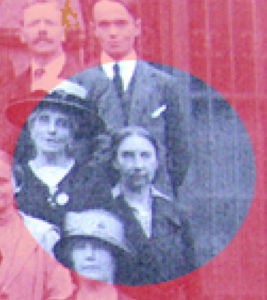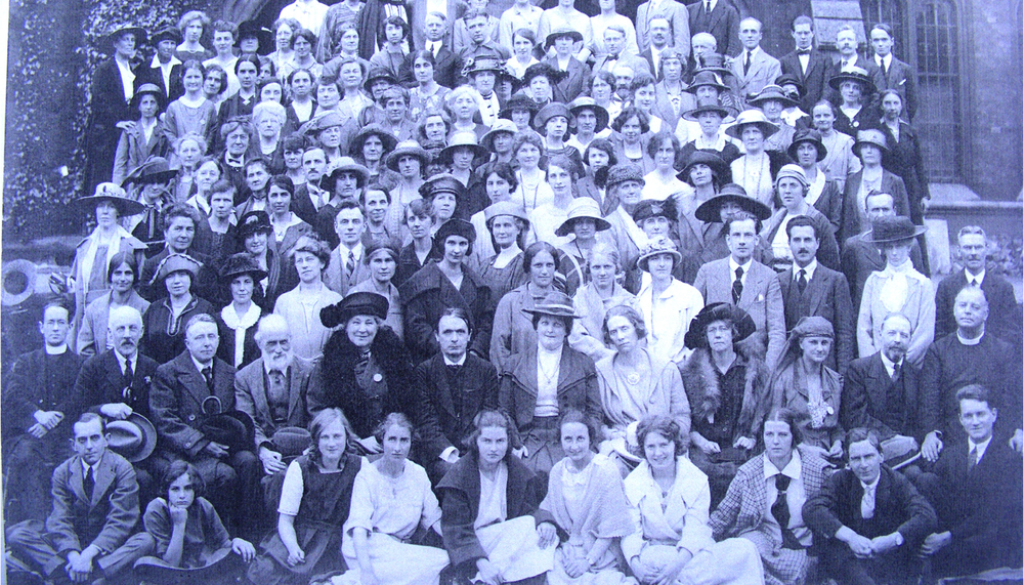Miss Cross
1866 - 1962
 As you can read in the council minutes of the original BDA Miss Cross rarely missed a meeting. Miss Cross – evidently quite camera-shy – is said to be the lady in the top right of the above photo, on the end of the row next to lady in the large black hat just in front of George Adams
As you can read in the council minutes of the original BDA Miss Cross rarely missed a meeting. Miss Cross – evidently quite camera-shy – is said to be the lady in the top right of the above photo, on the end of the row next to lady in the large black hat just in front of George Adams
Wikipedia and the Kings Langley School describe a real force of nature.
Dr Steiner met ‘that lady’ at Easter in 1922 – not for the first time – and reported on it.
Carl Meir wrote a little about Miss Margaret Cross:
“When I met Miss Cross first, she already gave the impression of an old person, old in the sense of ageless, and she hardly seemed to grow any older in the succeeding years. She was of small stature, bent, with a wrinkled face, but sparkling eyes. Her fingers were gnarled, her feet were encased in heavy shoes. One never met her but in heavy tweeds, carrying a large bag with papers and books. She lived in surroundings which seemed most befitting to her: a largish holding with many trees and bushes and shrubs, which gave at first sight the impression of neglect, until one discovered that more care was bestowed on it all than one thought. In the centre, the buildings of an old Dominican priory, modernised rather cleverly earlier this century, with farm buildings around. There was the same air of austerity in the house as one encountered in Miss Cross herself: an austerity in body-comforts, in meals, in light and warmth. And yet, it all had style. House and owner belonged together. When one opened the old-fashioned latch of her front door a spotlessly clean room greeted one, with that polish and almost loving austerity one meets in monasteries and convents. The bread she offered was home-made, the vegetables and fruit came from her own garden. All was simple, but all was the expression of Miss Cross.
She was one of the most learned and truly educated people I have ever had the privilege to meet. Her knowledge of English language and literature was profound, and alive. She was a classical scholar. And at my very last meeting with her – a few years before her death – I had a real surprise. She had broken her leg, and I asked whether I might see her to discuss a difficult matter over which in the past we had never quite come to an agreement. I was shown into her bedroom – furnished like a cell. There she was, undaunted by her age and her broken leg. She looked healthier than I had ever seen her before (it was probably the first time for years that she was warm and rested and properly nursed). She was in the most amiable mood, and our problem was settled within minutes. During a most animated conversation which made me forget her almost 90 years, I looked at the pile of books on her bed and bedside table. Next to a few books by Rudolf Steiner there was a whole collection of volumes on very advanced higher mathematics. ‘At last I have a chance of reading something about this. I have wanted to do so for a long time!’ Her eyes sparkled, and with her gnarled fingers which could hardly move she showed me some passages which had ‘thrilled’ her.
I think Miss Cross was a lonely person longing to do what this life had made difficult for her to accomplish. She was so strong a personality that co-operation with others did not come easily to her, and thus one missed in her school, for instance, that ‘College of Teachers’ which is an integral part of a Rudolf Steiner School. But she loved children so much that she taught almost to the end of her life.”
*
Alfred Heidenreich, who wrote an obituary of Margaret Cross for The Christian Community:
“During the last years of her life Miss Margaret Frances Cross had become a legend. She represented nearly a century, and her active memory extended over this great span of time. She was born on 22nd December 1866 at Preston, in the days when the industrial revolution left its ugly scars all over Lancashire. When she was two years old, her mother died. She then lived with her grandmother, and after her death went to Cambridgeshire, to her father’s family, into an atmosphere of agricultural peace and learning. Miss Cross received her higher education in Cambridge itself and then entered the university. While still a student, she agreed to help out as a teacher at the school of Miss Clark, who was one of the earliest pioneers of co-educational boarding schools in this country. The appointment, which was at first regarded as only temporary, became permanent, and the co-operation between Miss Clark and Miss Cross soon developed into a life-long partnership. Some time in the ’90s Miss Cross spent a period of study in Vienna. Of these years a photograph is in existence, which shows her as an extraordinarily beautiful young woman: a forehead behind which only clear thoughts seem to dwell, eyes quietly alert, beautifully balanced lips showing no trace of tension, and a well-formed chin in perfect proportion to the rest of her face. The picture conveys the impression of a woman in whom love dwells, more as a quiet state of will than as an emotion. She was obviously capable of great devotion to the ideals which she sought and the tasks which she set herself.
In 1909 Miss Clark and Miss Cross acquired the Priory at Kings Langley. Both kept abreast of the developments of modern educational thought, and particularly Miss Cross, the younger of the two partners, made it her aim to attend educational conferences. It was the late Professor Mack invited her to join her in order to hear Rudolf Steiner at December 1921. When Rudolf Steiner visited England he also called in on the Priory. His visits encouraged Miss Cross to begin to absorb the anthroposophical education into her own school…
Miss Cross was a tireless worker and her personal care a extended into every part of the Priory, be it the children the arrangements, the gardens, the farm animals, cows workshops, and all the other details which belong to such a living which combines education and farming. It may perhaps be added that the powerful will which enabled her to hold together so many interests made it also difficult for her to be equally open to the opinions and needs of others, especially in later life.
During her last years she became rather a lonely figure, although cared for with great loyalty and love. To those few who had the privilege of calling on her from time to time, she became increasingly a venerable presence. She had many minor and major accidents during the last few years of her life, but whenever she broke a bone in her body it seemed always miraculously to heal again. She was deeply concerned that the spirit which she had implanted in the Priory should be kept alive after her death, and that the Priory in some form or other should remain dedicated to the spirit and work of Rudolf Steiner.
We cannot doubt that her soul and spirit have joined now the faithful band whom Rudolf Steiner is gathering in the spiritual world, in order to prepare for a fresh life when the Spirit will call them for decisive actions.”
https://biographien.kulturimpuls.org/detail.php?&id=848
